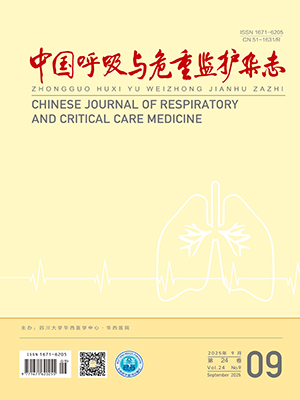| 1. |
卞大晨, 肖永龙, 刘布俊, 等.结缔组织疾病相关性间质性肺病与特发性间质性肺炎比较研究.中国呼吸与危重监护杂志, 2014, 13:263-267.
|
| 2. |
Bresser P, Jansen HM, Weller FR, et al. T-cell activation in the lungs of patients with systemic sclerosis and its relation with pulmonary fibrosis. Chest, 2001, 120:66S-68S.
|
| 3. |
Papakosta D, Manika K, Gounari E, et al. Bronchoalveolar lavage fluid and blood natural killer and natural killer T-like cells in cryptogenic organizing pneumonia. Respirology, 2014, 19:748-754.
|
| 4. |
Kotsianidis I, Nakou E, Bouchliou I, et al. Global impairment of CD4+CD25+FOXP3+ regulatory T cells in idiopathic pulmonary fibrosis. Am J Respir Crit Care Med, 2009, 179:1121-1130.
|
| 5. |
Dunn HS, Haney DJ, Ghanekar SA, et al. Dynamics of CD4 and CD8 T cell responses to cytomegalovirus in healthy human donors. J Infect Dis, 2002, 186:15-22.
|
| 6. |
Tang YW, Johnson JE, Browning PJ, et al. Herpesvirus DNA is consistently detected in lungs of patients with idiopathic pulmonary fibrosis. J Clin Microbiol, 2003, 41:2633-2640.
|
| 7. |
Yonemaru M, Kasuga I, Kusumoto H, et al. Elevation of antibodies to cytomegalovirus and other herpes viruses in pulmonary fibrosis. Eur Respir J, 1997, 10:2040-2045.
|
| 8. |
赖金梅, 黄旺, 苏玉琴, 等.脾氨肽口服冻干粉对慢性阻塞性肺疾病的疗效观察.医药前沿, 2012:232-233.
|
| 9. |
何志红, 郑颖, 金颖, 等.脾氨肽对支气管哮喘相关细胞因子调控的研究.国际呼吸杂志, 2015, 35:165-168.
|
| 10. |
American Thoracic Society/European Respiratory Society International Multidisciplinary Consensus Classification of the Idiopathic Interstitial Pneumonias. This joint statement of the American Thoracic Society (ATS), and the European Respiratory Society (ERS) was adopted by the ATS board of directors, June 2001 and by the ERS Executive Committee, June 2001. Am J Respir Crit Care Med, 2002, 165:277-304.
|
| 11. |
Goldin JG, Lynch DA, Strollo DC, et al. High-resolution CT scan findings in patients with symptomatic scleroderma-related interstitial lung disease. Chest, 2008, 134:358-367.
|
| 12. |
Josefowicz SZ, Lu LF, Rudensky AY. Regulatory T cells: mechanisms of differentiation and function. Annu Rev Immunol, 2012, 30:531-564.
|
| 13. |
Costantino CM, Baecher-Allan CM, Hafler DA. Human regulatory T cells and autoimmunity. Eur J Immunol, 2008, 38:921-924.
|
| 14. |
O'Reilly S, Ciechomska M, Cant R, et al. Interleukin-6 (IL-6) trans signaling drives a STAT3-dependent pathway that leads to hyperactive transforming growth factor-beta (TGF-beta) signaling promoting SMAD3 activation and fibrosis via Gremlin protein. J Biol Chem, 2014, 289:9952-9960.
|
| 15. |
Vittal R, Fan L, Greenspan DS, et al. IL-17 induces type V collagen overexpression and EMT via TGF-β-dependent pathways in obliterative bronchiolitis. Am J Physiol Lung Cell Mol Physiol, 2013, 304:L401-L414.
|
| 16. |
Giannopoulou M, Iszkula SC, Dai C, et al. Distinctive role of Stat3 and Erk-1/2 activation in mediating interferon-γ inhibition of TGF-β1 action. Am J Physiol Renal Physiol, 2006, 290:F1234-F1240.
|




